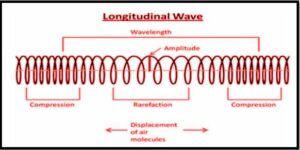Table of Contents
Longitudinal waves are waves in which the medium’s vibration is parallel (“along”) to the wave’s travel direction and the medium’s displacement is in the same (or opposite) direction as the wave’s propagation. Because they create compression and rarefaction when moving through a material, mechanical longitudinal waves are also known as compressional or compression waves.
A Brief Outline
The wavelength is the distance between the two consecutive compression or rarefaction areas. Constructive interference occurs when the compression and rarefaction zones of two waves coincide, whereas destructive interference occurs when the compression and rarefaction regions do not coincide.
Important Concepts
Longitudinal Wave Formula
y (x,t) = y0 cos[ω(t-x/c)]
y = displacement of the point on the travelling sound wave
x = distance the point travelled from the wave’s source
t = time elapsed
y0 = amplitude of the oscillations
c = speed of the wave
ω = angular frequency of the wave
Waves of Sound
The vibrating motion of particles travelling across a conductive media produces a sound wave, which is an example of a longitudinal wave. The tuning fork is an example of sound waves travelling in a longitudinal direction.
The difference between the greatest pressure created by the wave and the pressure of the undisturbed air is the amplitude of the wave in sound waves. The type, content, and temperature of the medium through which sound travels determine its propagation speed.

Compression of Longitudinal Waves Characteristics
Compression is the portion of a longitudinal wave where the wave’s particles are closest to each other.
Rarefaction
In a longitudinal wave, rarefaction occurs when the particles are the furthest apart from one another.
Frequency
The frequency of a longitudinal wave is the distance between the two back-to-back areas. These spots can be situated between the two constrictions or two rarefactions.
Plenty-fulness
The plenty fulness of a longitudinal wave is the separation from the medium’s balanced position to pressure or rarefaction
Recurrence and Period
The period is how much time it takes for a wave to travel one frequency.
The quantity of frequencies each second is the longitudinal wave’s recurrence.
Significance of longitudinal waves in IIT JEE exam
The Oscillations and Waves chapter, which accounts for 10% of the exam questions, covers a wide range of topics. All you have to do is grasp the concepts of each topic. If you stick to this plan, your Physics preparation would be spot on, and you’ll be able to pass this section with flying colours. As per the distribution of levels of difficulty in the previous year’s tests, basic and medium-level questions makeup roughly 83 percent of the JEE paper.
FAQs:
What are three longitudinal wave examples?
Sound waves, spring vibrations, tsunami waves, and so forth are examples of longitudinal waves.
What Characteristics Characterize Longitudinal Waves?
Wavelength, amplitude, period, frequency, and wave speed are all parameters of longitudinal waves, just as they are for transverse waves. The key distinction is that longitudinal waves include compressions and rarefactions instead of crests and troughs.
What are your thoughts on wave velocity?
Wave velocity is defined as the distance travelled in a motion per unit time in a cyclic or periodic fashion in any direction.








